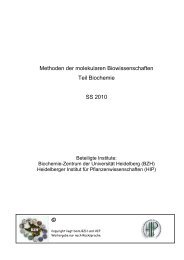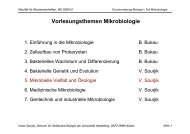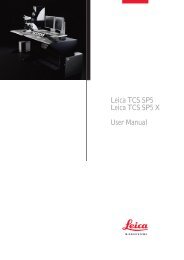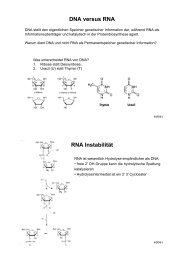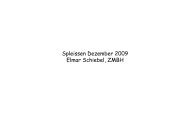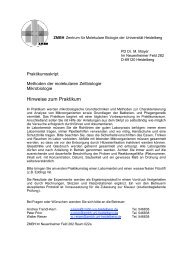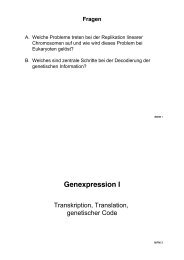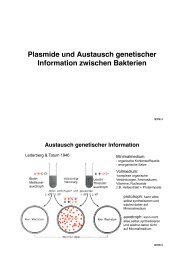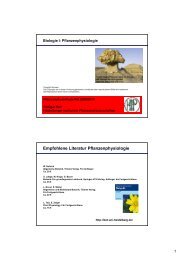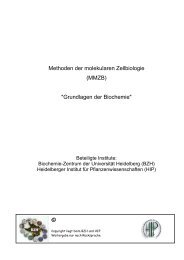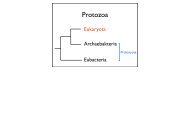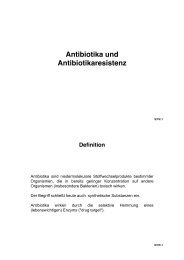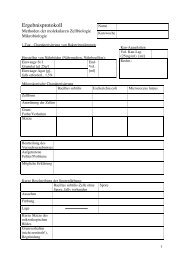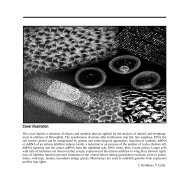ZMBH J.Bericht 2000 - Zentrum für Molekulare Biologie der ...
ZMBH J.Bericht 2000 - Zentrum für Molekulare Biologie der ...
ZMBH J.Bericht 2000 - Zentrum für Molekulare Biologie der ...
Create successful ePaper yourself
Turn your PDF publications into a flip-book with our unique Google optimized e-Paper software.
THESES<br />
Diploma<br />
Belz, Thorsten (1998). Untersuchungen zur Assoziation<br />
von Repressoren <strong>der</strong> Transkription aus Drosophila<br />
melanogaster mit Histon-Deacetylase-Aktivität.<br />
Kwoczynski, Simona (1998). Genetische Untersu–<br />
chung zum Mechanismus <strong>der</strong> STAT-abhängigen Transkriptionsaktivierung<br />
in Drosophila melanogaster.<br />
Bierlein, Nicole (1999). Untersuchungen zum Einfluß<br />
von Mutationen des TBP-assoziierten Faktors<br />
TAF II 250 auf die differentielle Genexpression in<br />
Drosophila melanogaster.<br />
STRUCTURE OF THE GROUP<br />
E-mail: f. sauer@mail.zmbh.uni-heidelberg.de<br />
Group lea<strong>der</strong> Sauer, Frank, Dr.<br />
Ph.D. students Beisel, Christian<br />
Belz, Thorsten<br />
Kwoczynski, Simona<br />
Dung-Pham, Anh<br />
Diploma students Egle, Markus*<br />
Bogin, Jochen*<br />
Tech. assistants Leibfried, Ute*<br />
Müller, Sandra<br />
* part of the time reported<br />
108<br />
Hans Ulrich Schairer<br />
I. Stigmatella aurantiaca, a Prokaryotic<br />
Organism for Studying Intercellular Signalling<br />
and Morphogenesis<br />
The organisms<br />
Stigmatella aurantiaca belongs to the myxobacteria<br />
that are Gram-negative soil bacteria. Myxobacteria<br />
show both, features of unicellular and multicellular<br />
organisms. As the eukaryotic organism Dictyostelium<br />
dicoideum they are thought to lie on the boundary<br />
between unicellular and multicellular organisms.<br />
Myxobacteria grow and divide as separate cells. But<br />
they may be regarded as a multicellular organisms<br />
whose cells feed in swarms and which un<strong>der</strong> conditions<br />
of starvation, assemble to well defined regular<br />
three dimensional structures called fruiting bodies<br />
which enclose about 10 5 dormant cells, the myxospores.<br />
The shape of the fruiting bodies is species specific<br />
and is genetically determined. The fruiting body<br />
of S. aurantiaca consists of a stalk bearing several<br />
sporangioles on branches at its top.<br />
Myxobacteria secrete hydrolytic enzymes together<br />
with slime with which they degrade particulate organic<br />
matter of the soil. It has been shown that the growth<br />
rate increases with cell density if myxobacteria were<br />
grown on a macromolecular substrate as sole nutrient,<br />
such as casein. This suggests that cells feed co-operatively<br />
and the association in a swarm allows them to<br />
feed more efficiently. The advantage of cooperative<br />
feeding may have driven the evolution of fruiting body<br />
formation. When nutrients are again available after a<br />
period of starvation, myxospores germinate and form<br />
vegetative cells. The multicellular nature of the fruiting<br />
body ensures that a swarm of cells is formed for a<br />
new growth cycle.<br />
Myxobacteria move by gliding on solid surfaces. This<br />
facilitates the stabilisation of a swarm and of fruiting<br />
body formation. Gliding permits tight cell-cell contact<br />
and efficient signal exchange between the cells<br />
by diffusible molecules. Both features are a prerequisite<br />
for the transmission of positional information of<br />
the single cell necessary for the coordination of the<br />
metabolism and movement of the cell in the course<br />
of fruiting body formation. One of the developmental<br />
signals – Stigmolone – that is involved in early cell<br />
aggregation has been recently isolated and characterised<br />
by Wulf Plaga et al.<br />
Apart from their ability to form fruiting bodies, myxobacteria<br />
form a broad range of secondary metabolites.<br />
All these unique features are reflected in the size of the<br />
genome and its organisation. The size of the myxobacterial<br />
genome has been shown to be about 9.5 Mbp.<br />
A gene cluster involved in S. aurantiaca fruiting<br />
body formation<br />
Susanne Müller, Barbara Silakowski and Diana Hofmann<br />
To investigate the genes involved in S. aurantiaca<br />
fruiting body formation and the co-ordination of their<br />
expression, Tn5 transposon insertion mutagenesis was<br />
performed. Three different mutant types impaired in<br />
fruiting body formation were detected by screening<br />
the insertional mutants. They include mutants that<br />
form neither fruiting bodies nor aggregates. mutants<br />
that aggregate to unstructured clumps, and mutants<br />
that un<strong>der</strong>go only part of the differentiation process.<br />
One of the mutants (AP182) that formed clumps<br />
during starvation was analysed further. Mixing of the<br />
109



